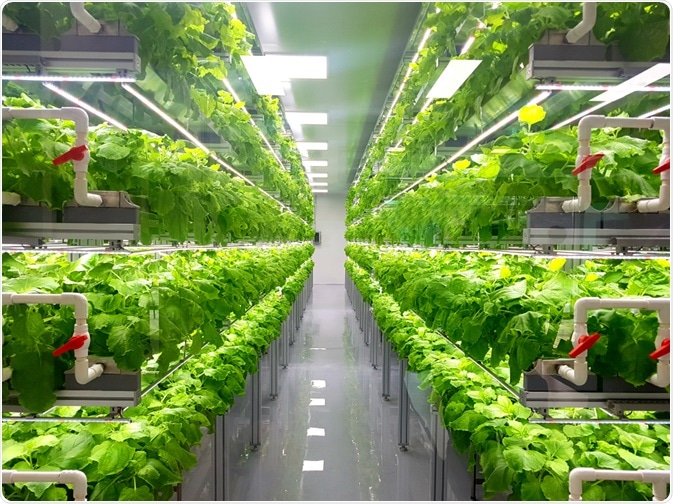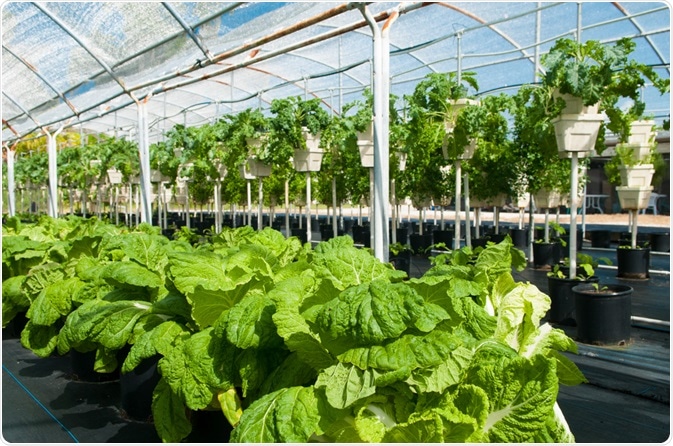It is estimated that 11 percent, or 1.5 billion hectares, of the world’s land is used for crop production, which represents over a third of the total land suitable for crop production. With a growing population and resource needs, the availability of arable land is going to decrease substantially. Consequently, such rapidly pressing needs should be matched by a higher rate of food production.

Image Credit: YEINISM/Shutterstock.com
What alternative solutions are there and what would they provide?
Throughout modern agriculture, conventional systems use large amounts of space, freshwater, fertilizer, and pesticides to maximize yield production and crop health to ensure food security, which unsustainable when looking into a future of widespread environmental and socioeconomic change.
In response, contemporary methods need to evolve to meet the current and predicted requirements of a growing world population.
Alternative solutions include the use of structural modifications such as vertical agriculture as well as entire systems by incorporating elements such as hydroponics, aeroponic, and aquaponics.
These strategies do not require fertile land to be effective, they require less water and space compared with the conventional agricultural systems and are able to increase the yield per unit of area. Additionally, these strategies use significantly fewer agrichemicals, which are potentially harmful to humans and animals.
As such, two strategies that hold promising interests is the implementation of vertical agricultural systems as well as hydroponics.
Integrating verticality into the design of agricultural systems
Agricultural systems have typically been spread over large spans of land as far as the eye can see. The reduction in arable land as well as the increase in demand to house growing populations, however, means that such strategies need to be reconsidered.
Rather than horizontal systems, large vertical walls covered crops can be used instead. These vertical layouts can employ soil, water, or air-powered systems to manage crops, and can be contained in greenhouses, warehouses, or other such facilities.
As a result, vertical agricultural systems, also known as verticulture, can encompass varying sizes and be located within many different areas from the middle of highly urbanized cities to more suburban or rural areas. The verticality aspect can also enhance nutrient and water flow, helping to reuse costly resources in a much better way than traditional methods, as demonstrated by an Indonesian research team in a study published earlier this year.
The potential location of vertical systems means that the cost of transport is nearly nullified as consumers may access them within urban areas. Moreover, the enclosed feature of verticulture means that pests and parasites are easily controlled, reducing the use of pesticides to a minimum. Finally, the reduction in space required means that there is a significant increase in yield per area, holding extensive potential for a future world of urbanization.
Despite such benefits, several limitations persist. Specifically, it is currently difficult and expensive to construct and manage such systems, which has limited their popularity. Some additional costs are also to be considered, particularly the artificial lighting that is required to help the plants grow. However, technological advances may help reduce the economic pressure of sustaining vertical systems as well as improve the overall efficiency of implementing these systems.
Are indoor vertical farms the future of agriculture? | Stuart Oda
The development of hydroponic strategies
The transformation of agricultural systems may also include changes in applied strategies. For instance, transitioning from primary soil-based systems may provide a range of advantages, particularly in a world undergoing considerable changes in environmental conditions.
In particular, the advent of hydroponic systems represents a strategy of soilless agriculture since it uses mineral nutrient solutions in aqueous solvents to grow crops.
By relying essentially on water and nutrients, hydroponic systems are able to reduce the requirement of space and pesticides. Crop demands for nutrients and water can be controlled precisely to optimize growth and adjust to other conditions. Additionally, hydroponics can be used with other strategies, such as verticulture, and be used to address additional non-agricultural issues in urban areas.
Indeed, not only are hydroponic systems easily manageable, but they can also help mitigate issues of sanitation and animal waste processing. For instance, a recent study by African researchers earlier this year demonstrated how treated municipal wastewater can be used to establish hydroponic systems that produce healthy and sustainable crops for consumption. Additionally, a German study from 2016 designed a double recirculating system based on fish waste as fertilizer for tomato plants, with very promising results.
Nonetheless, hydroponic systems rely heavily on water and management measures, making it an expensive solution even to this day. It is therefore difficult to implement such systems at much larger scales, particularly as water scarcity is increasingly frequent and severe in many regions around the globe. In response, the combination of hydroponics with other strategies including recirculating systems or vertical designs may hold additional potential.

Image Credit: Peter Acker/Shutterstock.com
Alternative strategies in an era of global environmental and socioeconomic changes
Conventional agricultural systems have considerable dependencies on space and resources. Using strategies such as vertical designs and elements including hydroponics could be sustainable alternatives as they require less water, less fertilizer, and less space. Such benefits are key to consider in a rapidly changing world, particularly in terms of saving space and energy.
Rising global temperatures and the increased frequency, as well as the severity of extreme weather events, has considerable implications for crop production around the world. Moreover, geographic regions that are predicted to undergo the most environmental changes are ones that are already under socioeconomic stress, therefore exacerbating existing disparities. In response, alternative strategies that incorporate elements of sustainability are urgently required.
However, many limitations remain when considering alternative agricultural systems. In particular, the cost-effectiveness of designing and implementing such strategies may be out of reach of many regions. In response, technological advances are expected to improve our understanding of crop management and reduce the costs of strategy implementation, which can directly help to inform sustainable strategies to increase efficiency and decrease reliance on resources.
Ultimately, strategies are likely to be used in combination to complement one another and reduce the limitations that may occur. Such a coalition of strategies holds promising potential for addressing current as well as future socioeconomic and environmental challenges, yet considerable research is still required to refine such a cause.
References
- Ichwan, N. et al. (2020) ‘Shallot’s growth and production under sub-surface irrigation in vertical agriculture (verticulture) system’, IOP Conference Series: Earth and Environmental Science. IOP Publishing, 454, p. 12044. doi: 10.1088/1755-1315/454/1/012044.
- Magwaza, S. T. et al. (2020) ‘Hydroponic technology as decentralised system for domestic wastewater treatment and vegetable production in urban agriculture: A review’, Science of The Total Environment, 698, p. 134154. doi: 10.1016/j.scitotenv.2019.134154.
- Suhl, J. et al. (2016) ‘Advanced aquaponics: Evaluation of intensive tomato production in aquaponics vs. conventional hydroponics’, Agricultural Water Management, 178, pp. 335–344. doi: 10.1016/j.agwat.2016.10.013.
Further Reading
Last Updated: Nov 26, 2020